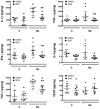Bosutinib Therapy Ameliorates Lung Inflammation and Fibrosis in Experimental Silicosis
- PMID: 28360865
- PMCID: PMC5350127
- DOI: 10.3389/fphys.2017.00159
Bosutinib Therapy Ameliorates Lung Inflammation and Fibrosis in Experimental Silicosis
Abstract
Silicosis is an occupational lung disease for which no effective therapy exists. We hypothesized that bosutinib, a tyrosine kinase inhibitor, might ameliorate inflammatory responses, attenuate pulmonary fibrosis, and thus improve lung function in experimental silicosis. For this purpose, we investigated the potential efficacy of bosutinib in the treatment of experimental silicosis induced in C57BL/6 mice by intratracheal administration of silica particles. After 15 days, once disease was established, animals were randomly assigned to receive DMSO or bosutinib (1 mg/kg/dose in 0.1 mL 1% DMSO) by oral gavage, twice daily for 14 days. On day 30, lung mechanics and morphometry, total and differential cell count in alveolar septa and granuloma, levels of interleukin (IL)-1β, tumor necrosis factor (TNF)-α, interferon (IFN)-γ, IL-4, transforming growth factor (TGF)-β, and vascular endothelial growth factor in lung homogenate, M1 and M2 macrophages, total leukocytes, and T cells in BALF, lymph nodes, and thymus, and collagen fiber content in alveolar septa and granuloma were analyzed. In a separate in vitro experiment, RAW264.7 macrophages were exposed to silica particles in the presence or absence of bosutinib. After 24 h, gene expressions of arginase-1, IL-10, IL-12, inducible nitric oxide synthase (iNOS), metalloproteinase (MMP)-9, tissue inhibitor of metalloproteinase (TIMP)-1, and caspase-3 were evaluated. In vivo, in silicotic animals, bosutinib, compared to DMSO, decreased: (1) fraction area of collapsed alveoli, (2) size and number of granulomas, and mononuclear cell granuloma infiltration; (3) IL-1β, TNF-α, IFN-γ, and TGF-β levels in lung homogenates, (4) collagen fiber content in lung parenchyma, and (5) viscoelastic pressure and static lung elastance. Bosutinib also reduced M1 cell counts while increasing M2 macrophage population in both lung parenchyma and granulomas. Total leukocyte, regulatory T, CD4+, and CD8+ cell counts in the lung-draining lymph nodes also decreased with bosutinib therapy without affecting thymus cellularity. In vitro, bosutinib led to a decrease in IL-12 and iNOS and increase in IL-10, arginase-1, MMP-9, and TIMP-1. In conclusion, in the current model of silicosis, bosutinib therapy yielded beneficial effects on lung inflammation and remodeling, therefore resulting in lung mechanics improvement. Bosutinib may hold promise for silicosis; however, further studies are required.
Keywords: lung fibrosis; lung mechanics; lymphocytes; macrophage polarization; regulatory T cells; tyrosine kinase inhibitor.
Figures










Similar articles
-
Dasatinib Reduces Lung Inflammation and Fibrosis in Acute Experimental Silicosis.PLoS One. 2016 Jan 20;11(1):e0147005. doi: 10.1371/journal.pone.0147005. eCollection 2016. PLoS One. 2016. PMID: 26789403 Free PMC article.
-
Therapeutic effects of bone marrow-derived mononuclear cells from healthy or silicotic donors on recipient silicosis mice.Stem Cell Res Ther. 2017 Nov 10;8(1):259. doi: 10.1186/s13287-017-0699-7. Stem Cell Res Ther. 2017. PMID: 29126438 Free PMC article.
-
Repeated administration of bone marrow-derived cells prevents disease progression in experimental silicosis.Cell Physiol Biochem. 2013;32(6):1681-94. doi: 10.1159/000356603. Epub 2013 Dec 13. Cell Physiol Biochem. 2013. PMID: 24356399
-
Lymphocytes, lymphokines, and silicosis.J Environ Pathol Toxicol Oncol. 2001;20 Suppl 1:53-65. J Environ Pathol Toxicol Oncol. 2001. PMID: 11570674 Review.
-
A mechanistic review of silica-induced inhalation toxicity.Inhal Toxicol. 2015;27(8):363-77. doi: 10.3109/08958378.2015.1066905. Epub 2015 Jul 21. Inhal Toxicol. 2015. PMID: 26194035 Review.
Cited by
-
Crystalline silica induces macrophage necrosis and causes subsequent acute pulmonary neutrophilic inflammation.Cell Biol Toxicol. 2022 Aug;38(4):591-609. doi: 10.1007/s10565-021-09620-1. Epub 2021 Jun 25. Cell Biol Toxicol. 2022. PMID: 34170461
-
Extracellular signal-regulated kinase signaling pathway and silicosis.Toxicol Res (Camb). 2021 May 7;10(3):487-494. doi: 10.1093/toxres/tfaa109. eCollection 2021 May. Toxicol Res (Camb). 2021. PMID: 34141162 Free PMC article. Review.
-
BMS‑345541 inhibits airway inflammation and epithelial‑mesenchymal transition in airway remodeling of asthmatic mice.Int J Mol Med. 2018 Oct;42(4):1998-2008. doi: 10.3892/ijmm.2018.3762. Epub 2018 Jul 6. Int J Mol Med. 2018. PMID: 30015827 Free PMC article.
-
Mechanisms of Cardiovascular Toxicity of BCR-ABL1 Tyrosine Kinase Inhibitors in Chronic Myelogenous Leukemia.Curr Hematol Malig Rep. 2020 Feb;15(1):20-30. doi: 10.1007/s11899-020-00560-x. Curr Hematol Malig Rep. 2020. PMID: 32078113 Review.
-
Comparative proteomic analysis of silica-induced pulmonary fibrosis in rats based on tandem mass tag (TMT) quantitation technology.PLoS One. 2020 Oct 29;15(10):e0241310. doi: 10.1371/journal.pone.0241310. eCollection 2020. PLoS One. 2020. PMID: 33119648 Free PMC article.
References
-
- Bates J. H., Decramer M., Chartrand D., Zin W. A., Boddener A., Milic-Emili J. (1985). Volume-time profile during relaxed expiration in the normal dog. J. Appl. Physiol. 59, 732–737. - PubMed
LinkOut - more resources
Full Text Sources
Other Literature Sources
Research Materials
Miscellaneous

